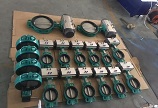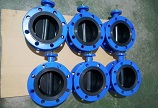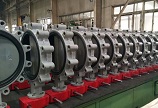24/7 Emergency Service
+86 185 2662 3967
Contact Us Now!
24/7 Emergency Service
+86 185 2662 3967
Contact Us Now!
Jan. 17, 2022
The gate valve is the most common valve in water supply systems. It represents a linear motion isolation valve that has the function of stopping or allowing flow. Gate valves get their name from the closing element that slides into the flow stream to provide closure, thus acting as a gate. Gate valves are used to isolate specific areas of the water supply network during maintenance, repair work, new installations, and to reroute the flow of water throughout the pipeline.
Resilient seat gate valves with non-rising spindle consist of:
wedge
Ductile iron valve body
resting area
valve stem
Spindle bearing
Engine cover
Packing.
The valve body is the largest element of the gate valve. Since the spindle remains in the valve body during rotation, an economical bonnet construction is possible. The bonnet itself is bolted to the valve body for easy cleaning and maintenance. As the gate valve closes, the wedge moves down until it presses against the seat, which means it is completely closed. During opening, the wedge slides toward the top of the valve body.

Based on construction, water system gate valves can be generally classified as follows.
By wedge shape: parallel gate valves and wedge gate valves
By seat: metal seat or resilient seat gate valve
By stem: with rising or non-rising stem
Parallel sliding gate valves have a flat, parallel-faced gate-like closing element mounted between two parallel seats. The so-called knife gate valve is a type of parallel gate valve.
Wedge gate valves are named because of the wedge-shaped gate plate. The wedge is ribbed on both sides and guided by a slot in the body of the gate valve.
Wedge gate valves can have either metal or resilient seats. In metal-seated gate valves, a wedge slides into a recess in the bottom of the gate valve body, which typically traps solids contained in the fluid. For this reason, resilient seat gate valves provide a tighter shutoff and are preferred in water distribution systems.
The difference between rising stem and non-rising stem is that they can be fixed (rising stem) or threaded (non-rising stem) to the gate. In a rising stem gate valve, the rotating stem rises as the valve opens. Some of the obvious disadvantages of rising stem valves are
Due to their bulky design, they require more space to open as the spindle moves upward.

EGYPT Standard F4 3352 Ductile Iron Gate Valve
Gate valves are typically operated by a handwheel, valve T-key (wrench), or actuator. The wheel is attached to the valve stem and transmits rotational energy to it. During the opening of the gate valve, the rotation of the handwheel screws the threads of the gate stem into the gate and vice versa to close it. This energy moves the gate valve wedge down or up. In underground gate valve installations, an extension shaft is attached, which allows operation without direct contact with the valve itself.
Typically, gate valves are installed in areas of the pipeline that will remain open or closed for longer periods of time, as they usually require some time to switch between these two positions. However, when the valve needs to be operated frequently or even remotely, an electric gate valve can be used.
Because gate valves are isolation valves, they must be used in the "fully open" or "fully closed" position and must not be used to regulate water flow. When throttling gate valves, turbulence through the valve body can cause vibration and cavitation, damage to the wedge and seat, and ultimately lead to leakage and poor sealing ability.
Tianjin LIWEI Valve Co., Ltd. is located in Jinnan Shuangqiaohe Town Industrial Park. It was established in 2003 by relying on Tianjin Jiantang Valve Co., Ltd. The company’s leaders conduct corporate management with advanced business philosophy and respect the corporate atmosphere of knowledge, enabling many scientific and technological personnel to display their talents in the development of the company, and constantly seek innovation and quality to develop new products.
Please contact us now and get the quote, we'll be happy to receive your emails.
Search Blog
Sep. 08, 2022
Tianjin Liwei Has Professional Valve Production Line
Sep. 07, 2022
Are You Interested in Small Order with Fast Delivery?
Aug. 25, 2022
Keywords

Factory Add.:
No.3 Xintai Road, Jinnan District, Tianjin, China.
Office Add.:
C12 Aliyun Jinnan District, Tianjin, China.
Name: Riven Lee
Mob.: +86 185 2662 3967
E-mail: trading_manager@liweivalve.cn
Name: Ariel Wong
Mob.: +86 186 9809 4027
Name: Kerry Zhang
Mob.: +86 187 2267 7875
Navigation
Products
Leave a Message


